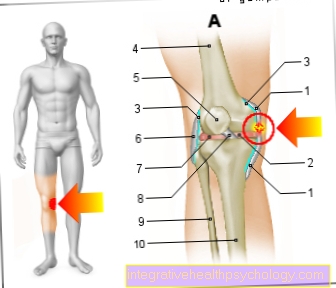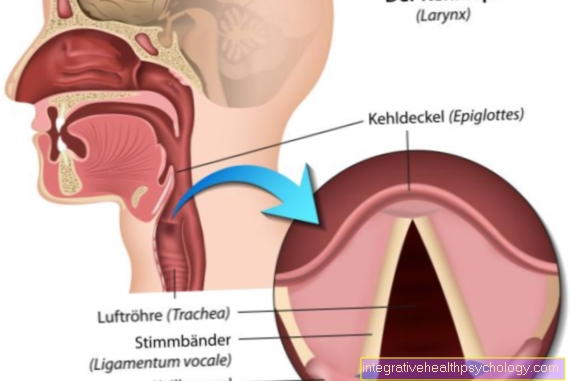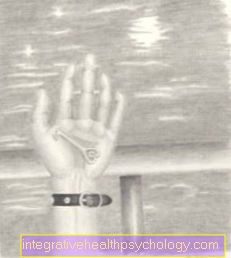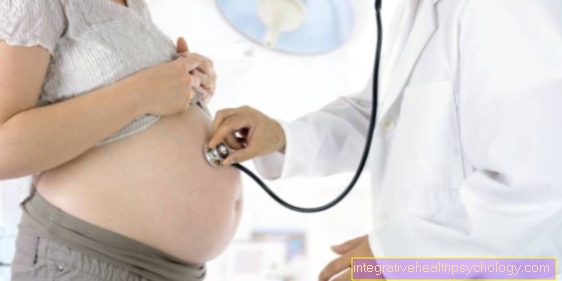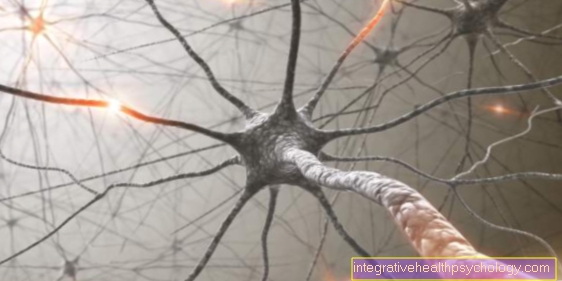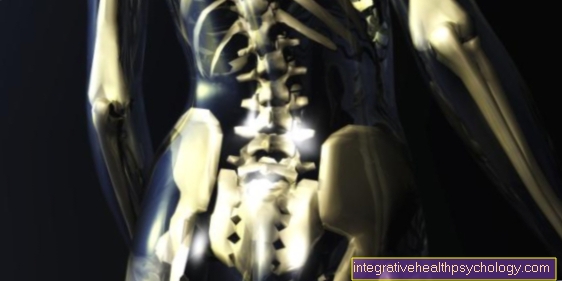Intestinal cramps
introduction
Intestinal cramps are very painful complaints that often severely restrict the person concerned in their everyday activities. It is mostly wave-like pain that is localized from about the navel down. The causes of these cramps can be diverse and accordingly vary in their severity, duration and severity. Below are some possible causes of bowel cramps.
General information about abdominal cramps at: Cramps in the abdomen

causes
There are many different causes that can potentially underlie bowel cramps. What is actually the cause can often only be found out by a doctor - especially in the case of persistent intestinal cramps.
Gastroenteritis:
One cause of intestinal cramps can be infectious gastroenteritis. This is popularly known as "gastrointestinal inflammation" and can be caused, for example, by certain bacteria (Campylobacter, Salmonella) or viruses (noroviruses, rotaviruses, other enteroviruses). In addition to the abdominal pain, there is usually diarrhea and / or vomiting. The symptoms usually subside after a few days. But not only gastroenteritis, but also duodenitis (inflammation of the duodenum) can be the cause of intestinal cramps.
Meteorism:
A lot of air in the intestine can also lead to very uncomfortable intestinal cramps. Stool or kinks in the bowel make it difficult for the air to escape at times and can then cause pain. Typically, symptoms improve once the stool or air is deflated. After consuming food that is very flatulent, there may be increased development of intestinal gases. The associated intestinal cramps are then more common.
Also read: Intestinal cramps without diarrhea
Food intolerance:
People who are allergic to certain foods can react with intestinal cramps, diarrhea, nausea and vomiting after consuming them. This occurs most often with a milk protein allergy (lactose intolerance). The symptoms usually start about 15 to 30 minutes after consuming the protein-containing products; but after two hours at the latest. In addition to the symptoms described, those affected often notice a strong rumbling in the stomach, which is caused by the increased movement of the bowel.
Chronic inflammatory bowel disease:
The most important chronic inflammatory bowel diseases include Crohn's disease and ulcerative colitis. Both can cause intestinal cramps and are often associated with slimy or bloody diarrhea. In Crohn's disease in particular, there are often fistulas or purulent abscesses in the anal area. The diseases typically progress in flare-ups.
Read more on the subject at: inflammatory bowel disease
Appendicitis (appendicitis):
Appendicitis can also cause intestinal cramps. As a rule, the pain begins in the upper abdomen and then moves to the right lower abdomen. Typical is tenderness at certain points in the right lower abdomen (Lanz and McBurney point). The contralateral pain of letting go is also seen as a sign of acute appendicitis. To do this, the examiner presses into the left lower abdomen and then suddenly lets go. This causes pain in the right lower abdomen in the case of appendicitis.
Irritable Bowel Syndrome:
Irritable bowel syndrome manifests itself as cramp-like abdominal pain, changing bowel habits (constipation, diarrhea, alternating), bloating and flatulence. These symptoms must have persisted for several months without any other organic cause to be called irritable bowel syndrome. The triggers are often stressful situations with strong psychological stress; an exact cause for the irritable bowel syndrome has not yet been found.
In addition to the causes mentioned, the intestinal cramps can also be caused by other factors. The bowel itself does not always have to be the cause of the symptoms. An inflammation of the stomach lining, stomach ulcers, kidney stones, gallstones or cancer can also cause the supposed intestinal cramps.
Intestinal obstruction (ileus):
An intestinal obstruction can occur if the intestine is obstructed by hard stool, foreign bodies or tumors, or if the bowel movement is paralyzed (for example by certain drugs).
The first variant is referred to as mechanical, the second as paralytic ileus. In both cases, the intestinal obstruction can manifest itself as nausea, vomiting, stool retention and severe, cramp-like abdominal pain. In the case of a mechanical ileus, a quick surgical intervention is usually indicated, as otherwise the intestinal parts threaten to die off and tear (perforation). This can lead to serious blood poisoning and death.
This article might also interest you: Intestinal cramps with diarrhea.
Symptoms

Intestinal cramps are often expressed by sudden onset, different strong pain in the abdominal region. They can be so strong that the person concerned cannot hold out in an upright position, but the Tighten legs reflexively got to. Depending on the cause of the cramps, they last for different lengths of time and can vary greatly in their severity. They can also be accompanied by other symptoms, such as diarrhea, Vomit, nausea, fever, Weight loss, general malaise, weakness, increased bowel noises and Flatulence be accompanied.
Localization of intestinal cramps
Left intestinal cramps
In the majority of the illnesses causing the disease, intestinal cramps occur simultaneously or with a delay in different areas of the abdomen. You can be sideways or wandering - it is not uncommon for the main pain to be felt elsewhere after minutes or hours. The page is mainly relevant when the pain is very severe. Left-sided cramps can then be an indication of a kidney stone that cannot pass the urinary tract due to its size. Often the pain moves downwards over time because the kidney stone is slowly transported towards the urinary bladder. If untreated, kidney stones can lead to kidney weakness and should be presented to a doctor immediately if they are suspected.
Read more on the subject at: Kidney stones
Intestinal cramps on the right
Severe cramps on the right side of the abdomen occur in a variety of diseases. In most cases, they are not just limited to the right side, but occur in other parts of the abdomen as well.
exceptions are Gall and kidney stone disease. This can manifest as severe, cramp-like pain on the right. Gallstones occur more frequently in middle-aged women and cause cramps mainly in the upper, right abdominal area. Besides that, they can too Stool irregularities and one Yellowing of the skin to lead. If left untreated, they can lead to liver failure and can be life-threatening - therefore, if gallstones are suspected, a doctor should be consulted early on
diagnosis

First the doctor looks at the belly from the outside and pay attention visible swelling or one Overinflation. By Touch and Knock of the abdomen, the doctor can determine whether there is more air in the intestine and whether a particular area is causing the patient particularly severe pain.
Does the patient suffer from other symptoms such as diarrheaso can a stool sample on infectious agents to be examined.
For example, a Ultrasound scan of the abdomen show any changes. If this is not enough and the doctor suspects one more serious cause for the discomfort so may other diagnostic procedures to get voted. This includes, for example Computed Tomography (CT). The CT can be performed with or without contrast agent. The patient becomes it pushed into a kind of tubewho makes many sectional images of the abdomen. Colon cancer and constricting processes of the intestines can be prevented using this method clearly visible be made.
Alternatively, a Gastrointestinal reflex performed (gastroduodenoscopy, Colonoscopy). This will give the patient a tube by mouth and esophagus through the stomach to the intestines introduced. The doctor can see the on a screen Mucous membrane of the gastrointestinal tract judge, see bleeding or discover growths of the mucous membrane.
During a colonoscopy, the tube is attached to the camera introduced through the anusso that in this case the colon mucosa can be assessed. This also serves the Cancer screening.
Ultimately, a MRI of the abdomen are made in which the Intestinal walls and abdominal organs of the patient can be assessed.
Especially if you put contrast media in the small intestine beforehand, you can use the special Sellink technique to show many pathologies in the soft tissue.
Please also read our topic: MRT in Sellink technology
therapy
The treatment of intestinal cramps depends on the cause. Infectious gastroenteritis usually improves within a few days, even without treatment. You only have to pay attention to a sufficient supply of fluids and electrolytes. In rare cases, a bacterial infection may require the use of an antibiotic.
Surgical interventions may be necessary in the case of malignant diseases, stone diseases and intestinal obstruction. In most cases, appendicitis is also corrected surgically. Otherwise, conservative therapy is usually used.
In the case of cramp-like complaints, heat can be helpful in relieving them. If a food allergy triggers intestinal cramps, these foods should be avoided if possible. Sometimes the doctor will also prescribe antispasmodic medication to help alleviate the symptoms.
Please also read our main article on the subject: What works best against intestinal cramps?
Drugs for intestinal cramps
How intestinal cramps are treated depends largely on the underlying cause. Some diseases that cause intestinal cramps can only be influenced slightly by medication, while others improve quickly without the use of medication.
However, the pain associated with intestinal cramps can be treated with pain relievers such as ibuprofen, diclofenac, naproxen, or metamizole in almost any type of intestinal cramp. These drugs work well for intestinal cramps caused by inflammation of the gastrointestinal tract - for example, a gastrointestinal infection or a chronic inflammatory bowel disease. In addition, the antispasmodic butylscopalamin, known to many as "Buscopan" or "Spasman", can be used. It relaxes the muscles in the gastrointestinal tract and thus counteracts the pain-producing stimulus. It should be noted that pregnant women, breastfeeding mothers and people with heart failure should not take this drug or only take it under special circumstances.
If intestinal cramps occur as part of an irritable bowel, so-called probiotics can help. These are foods or medicines that contain benign strains of bacteria such as bifidobacteria or lactobacteria. After replication in the intestine, these can stabilize the intestinal flora and reduce intestinal cramps. In some cases, linaclotide, a recently approved drug with digestive and pain relieving properties, can also relieve irritable bowel symptoms.
Read more on the subject at:
- Irritable bowel drugs
- What works best against intestinal cramps?
Homeopathy for intestinal cramps
If dangerous causes for the intestinal cramps are excluded, the homeopathic approach can also be useful to alleviate the symptoms in addition to conventional medicine. That should be borne in mind in studies so far no effectiveness of homeopathic remedies proven even if they are described as helpful in individual reports.
Remedies that are often used for intestinal cramps are Magnesium phosphoricum, belladonna, carbo vegetabilis and preparations containing chamomile.
prophylaxis
There is no direct prophylaxis to avoid intestinal cramps. However, if the trigger that causes the symptoms is known, it should be avoided as far as possible.
Just at stress-related bowel cramps is it helpful to stand next to the mental stress to create enough balance in your free time. Physical exercise is particularly suitable for this. Also a healthy one, not too high in fat nutrition high in fiber helps stimulate and maintain normal digestive activity. It should focus on a adequate hydration of at least 2l a day should be observed. In general, abstaining from alcohol and nicotine is also advisable in order to practice a healthy lifestyle.
Intestinal cramps during pregnancy
Intestinal cramps occur significantly more common in pregnant women than in the normal population. In most cases, they are harmless and do not require therapy. They arise, among other things, through pregnancy-related Hormonal changes, which can lead to a relaxation of the intestinal muscles, thereby to an expansion of the intestine and consequently to intestinal cramps. The stretching of muscles and ligaments in the abdomen as well as the increased pressure due to the constantly growing child can also manifest as intestinal cramps. These pains can usually be prevented by drinking large amounts of water, eating high-fiber foods and exercising. During pain attacks, relaxation, rest and the application of heat to the stomach, for example with a heat pad, can be beneficial.
In addition to intestinal cramps, other symptoms such as Fever, diarrhea, or vomiting on, this is a sign that a Disease of the gastrointestinal tract present. As with non-pregnant women, a number of diseases can be the cause of the symptoms. In rare cases, abdominal cramps along with vaginal bleeding may occur before the pregnancy is completed. This can indicate a premature birth.
Intestinal cramps after the removal of the uterus
A hysterectomy is necessary in women, for example, in the context of problems during childbirth, tumors or chronic pelvic pain. Arise during the operation Wounds in the abdomenwhich cause cramping pain in some women. Short-term, mild intestinal cramps are usually harmless as long as no other symptoms appear. In addition to the female sexual organs, the operation also irritates the bladder and intestines. This, too, can temporarily lead to intestinal cramps.
How often bowel cramps and other complications occur after a hysterectomy depends, among other things, on the patient Surgical method from. If the uterus has been removed vaginally, abdominal discomfort occurs less frequently. If radiation therapy was carried out before or after the removal of the uterus due to a tumor, the radiation may be the cause of the cramps. In this case, the symptoms are brief and should be completely gone after a few days.
Dive the Discomfort repeated weeks or months after the operation on, do you need one quick clarification. They can be due to various diseases of the remaining genital organs and the gastrointestinal tract. For example, some patients develop adhesions within the abdominal cavity due to irritation during the operation. Such adhesions usually cause no symptoms, but can also trigger pain and intestinal cramps.
Intestinal cramps and diarrhea
Intestinal cramps, diarrhea and fever can occur together in various diseases of the gastrointestinal tract and the digestive organs. One of the most common symptoms is gastrointestinal infections. Depending on the pathogen and previous illnesses of the person concerned, such an infection can be harmless or cause severe symptoms. In the majority of those affected, it is caused by viruses, is accompanied by vomiting and diarrhea for 2-5 days and then heals without consequences. In more severe cases, prolonged diarrhea, nausea and vomiting, fever, slimy stool, or blood in the stool may occur.
The combination of diarrhea, vomiting and fever causes the body to lose a lot of fluids and can dry out. This can lead to circulatory problems and under certain circumstances become life-threatening. In the case of severe intestinal cramps in combination with diarrhea, high fever and vomiting, medical help should be sought at an early stage. In severe cases, hospitalization is often unavoidable.
In practice, affected patients are usually asked to submit a stool sample, especially if there are accompanying symptoms such as mucus in the stool or fever. This is examined for various pathogens. If bacteria such as E. coli, Salmonella or Campylobacter are responsible for the gastrointestinal infection, the disease can be treated with antibiotics. One sign that bacteria are causing the symptoms is buildup of mucus on the stool. If viruses are the cause, antibiotics will not work.
Regardless of the pathogen, it is important to drink plenty of fluids and eat light foods if the symptoms persist. These include, for example, boiled carrots, potatoes, lye pastries and tea. Very sweet, sour, salty and spicy foods should be avoided.
In addition to gastrointestinal infections, intestinal cramps can occur together with diarrhea, fever, nausea and mucus in the stool in chronic inflammatory bowel diseases. These are diseases in which, due to various factors, the immune system in the gastrointestinal tract overreacts and repeatedly causes inflammation. For the majority of those affected, they run in episodes: Complaints appear in phases over the years, in between patients are symptom-free. Which symptoms occur and how severe they are depends largely on the severity of the attacks.
The most important diseases from this group are Crohn's disease and ulcerative colitis. They usually occur in young people and can have lasting health damage without appropriate therapy. Therefore, people who experience repeated phases of intestinal cramps, diarrhea, nausea, fever or slimy stools over a period of several months are strongly advised to consult a family doctor or gastroenterologist.
Read more on the subject at: Slimy diarrhea and inflammatory bowel disease
Intestinal cramps with flatulence
If flatulence occurs repeatedly together with intestinal cramps, there is usually no worrying illness behind it. In the vast majority of cases, one leads Malnutrition leading to increased gas formation in the intestine and thereby triggers increasing and decreasing pain. Avoiding flatulent foods such as peas, various types of cabbage, onions, lentils, unripe fruit, or carbonated drinks can often alleviate the symptoms. In addition, care should be taken to chew thoroughly when eating, otherwise a lot of air is swallowed together with the food, which can exacerbate the symptoms.
Intestinal cramps with bowel movements
If bowel cramps occur repeatedly before bowel movements and improve after the bowel has been emptied, this is often one constipation or a low-fiber diet is the cause. Hard, dry stools take longer to pass through the intestines and are consequently excreted late. Correspondingly larger amounts of gases and stool can collect in the sections of the intestine in front of them and cause intestinal cramps during digestive movements. To counteract this, should more fiber can be consumed with meals. These are found in large quantities in fruits and vegetables, for example. In addition, stool remains softer and passes through the intestines faster if enough fluid is ingested - at least 2 liters per day.

